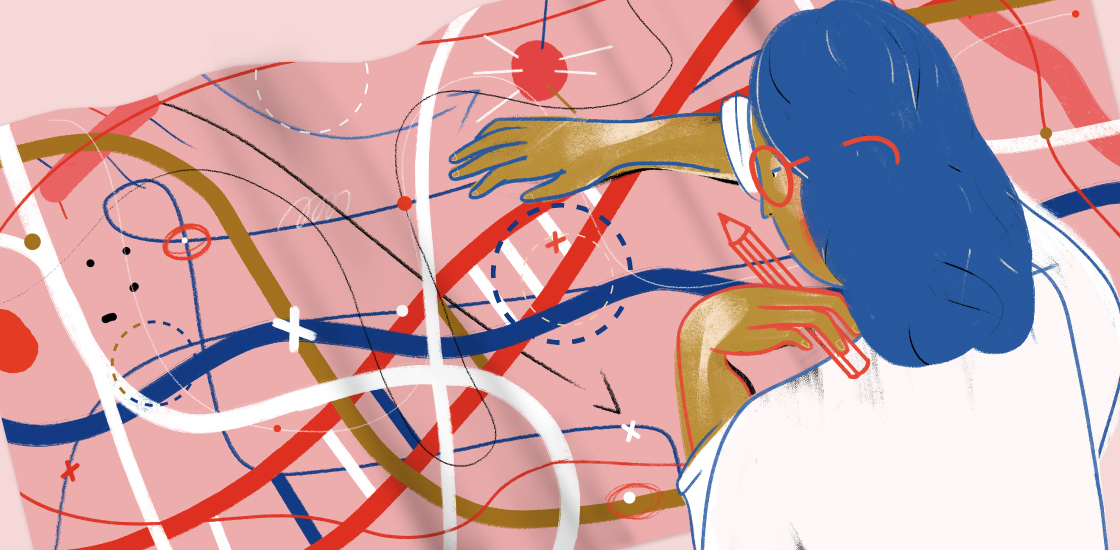About one-third of the HNRNP gene family’s 33 members may be associated with neurodevelopmental conditions, including autism, according to a new study. Of those 12 genes, 7 have not previously been linked with any neurodevelopmental condition.
The human genome contains numerous genes that developed from duplications of other genes. The original gene and all its duplications, called a gene family, tend to play similar roles in the cell. HNRNPs, for example, code for proteins that bind to RNA and help control where, when and how it gets translated.
The study is the first to use such patterns of relatedness among genes to look for new genetic syndromes. The results were published in April in Genome Medicine.
Tapping into these patterns of relatedness could make it easier to parse the vast volume of available human genomic data in search of new autism-linked genes, says study investigator Madelyn Gillentine, a variant scientist at Seattle Children’s Hospital in Washington.
“We have thousands, almost, of genes that are implicated in neurodevelopmental disorders,” she says. “And gene discovery has far outpaced our ability to clinically characterize them.”
But a gene-family-based approach may enable researchers to move from analyzing genes one by one to studying functionally related groups, says Santhosh Girirajan, associate professor of biochemistry and molecular biology at Pennsylvania State University in University Park, who was not involved in the study.
Otherwise, researchers are operating like the three blind men in the fable, each one holding a different part of an elephant and being unsure what the animal is, Girirajan says. “One [person] is holding the trunk, another holding the tail, and I think these guys are saying, ‘Let’s hold [all of its] legs, instead of one leg at a time.’”
All in the family:
The HNRNP gene family was a promising place to start their analysis, Gillentine says, because five HNRNP genes, including the autism-linked gene HNRNPU, are already implicated in neurodevelopmental conditions.
Using the publicly available GTEx dataset, she and her colleagues examined where in the body the HNRNP genes are expressed. All 33 are expressed throughout the brain, both during development and in adulthood, they found. But expression levels are particularly high in radial glia. These cells ultimately give rise to all of the brain’s neurons, and they form the scaffold along which neurons migrate during brain development, so mutations could substantially disrupt that process.
The team scanned several databases that together contain the genome sequences of more than 80,000 people with neurodevelopmental conditions, including autism, intellectual disability and other developmental delays. They homed in on a dozen members of the HNRNP family, each mutated in at least three people.
The patterns of traits associated with mutations in these 12 HNRNP genes strongly resemble one another, which suggests that the mutations may have similar functional effects. But there could be another explanation, Gillentine says: All of the people included in the analysis have neurodevelopmental conditions that have affected their daily lives enough to lead them to genomic testing.
Still, the collections of traits associated with HNRNP genes are more similar to one another than to traits associated with other genes linked to neurodevelopmental conditions, the team found.
“It shows that these [genes] are actually a related gene family,” Gillentine says. “We’re not just pulling out and preparing random genes.”
Numbers game:
Not all 12 genes reached significance according to conventional metrics for assessing gene candidates, however. Only three clearly exhibited high levels of de novo, or spontaneously occurring, variants in the dataset.
But as members of this gene family, the other nine genes deserve further study, says lead investigator Evan Eichler, professor of genome sciences at the University of Washington in Seattle.
“[We] consider these latter genes candidates [as well],” he says. “By investigating the phenotypes of these trending … genes, we gather additional support in favor of their role in disease.”
With more data, Eichler says, those genes might show evidence of significance. And the fact that these HNRNP genes have been identified as candidates might make finding that evidence easier.
Sometimes genomic data may never be published or shared because researchers can’t determine its importance, says Maria Chahrour, assistant professor neuroscience at the University of Texas Southwestern Medical Center in Dallas, who was not involved in the study.
“Oftentimes these variants are just sitting [around] because people don’t know what to make of them,” she says. “But then when they see a report like this, they’re more encouraged.”
For those few people who have such rare mutations, Gillentine says, identifying the genes can make a big difference. “Even though there’s only three people, it’s still really important to identify [them] and try to give them some kind of community with [people who have mutations in] similar genes, so that they can not feel as isolated.”






